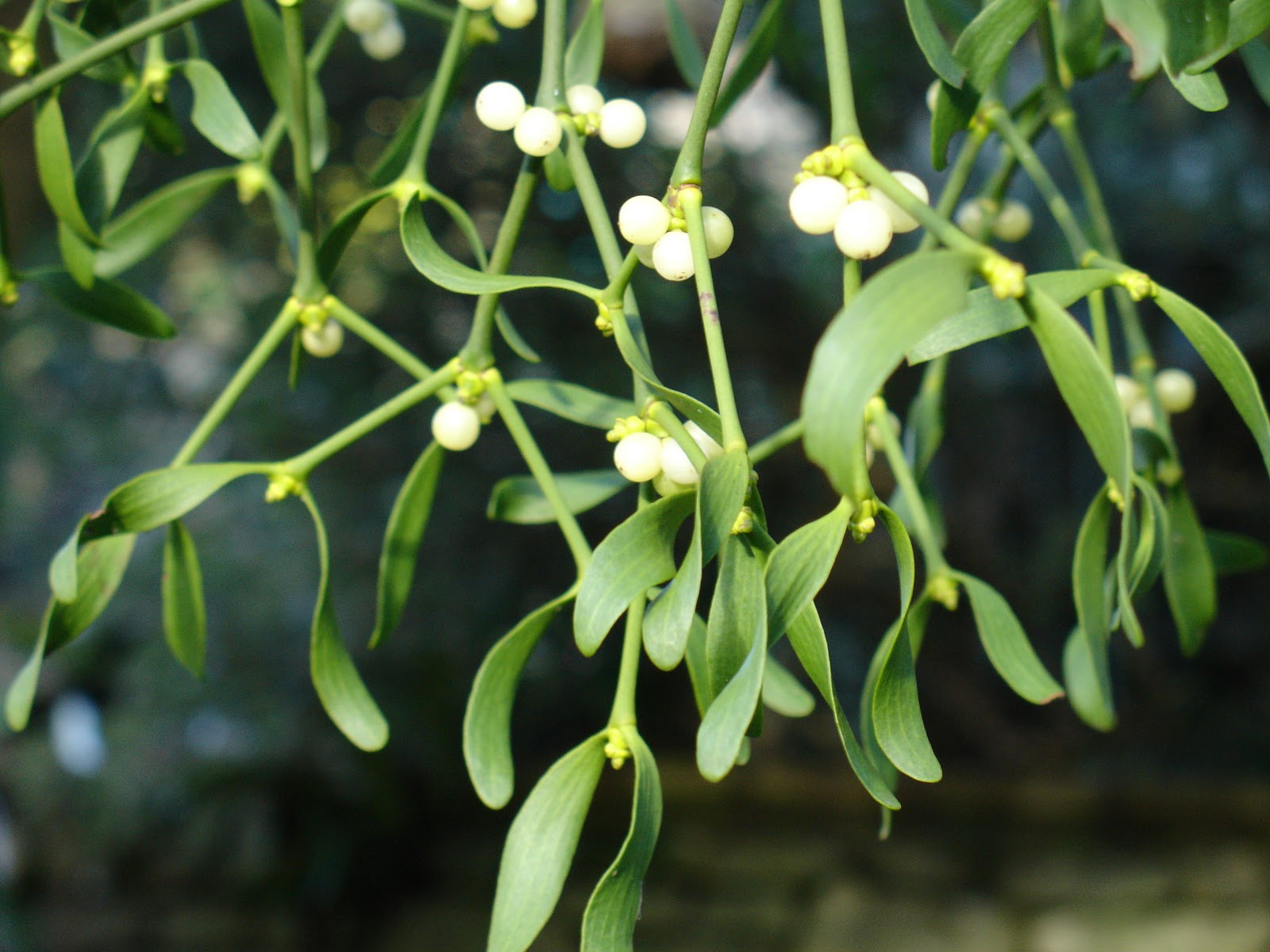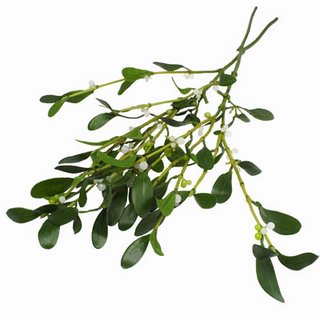
 Merry Christmas!
Merry Christmas!
Last Christmas, we looked at the quackery surrounding myrrh. This year, it is time for me to have little whine about mistletoe. Christmas would not be the same without a little cheeky kiss under this herb – usually with someone you really ought not to. But, its role at Christmas undoubtedly stretches back in time to more paganistic practices.
According to Pliny the Elder, it was central to Druid rituals:
After due preparations have been made for a sacrifice and a feast under the tree, they hail it as the universal healer and bring to the spot two white bulls, whose horns have never been bound before. A priest clad in a white robe climbs the tree and with a golden sickle cuts the mistletoe, which is caught in a white cloth. Then they sacrifice the victims, praying that the gods will make their gifts propitious to those to whom they have given it.
They believe that a potion prepared from the mistletoe will make barren animals to bring forth, and that the plant is a remedy against all poisons.
Nowadays, the web is full of claims about how injecting cancer patients with mistletoe extract can have remarkable effects. In many European countries it is not really seen as part of alternative medicine but as part of the oncologists repertoire. In 2002, mistletoe extract was the most frequently prescribed therapy in German outpatient cancer clinics. You may find that it goes by the trade name Iscador when you look for it online.
But the evidence for its effectiveness is rather weak. This year, the Cochrane review published the result of a thorough investigation into the evidence. They noted the high usage in Europe saying, “Proponents claim that mistletoe extracts stimulate the immune system, improve survival, enhance quality of life and reduce adverse effects of chemo- and radiotherapy in cancer patients. ”
However, after reviewing the evidence, they concluded,
The review found that there was not enough evidence to reach clear conclusions about the effects on any of these outcomes and it is therefore not clear to what extent the application of mistletoe extracts translates into improved symptom control, enhanced tumour response or prolonged survival. Adverse effects of mistletoe extracts were reported, but appeared to be dose-dependent and primarily confined to reactions at injection site and mild, transient flu-like symptoms.
Not very good news if you were thinking that mistletoe could be the answer.
So, how did the popularity of mistletoe come about? The answer is quite strange. The idea that injecting mistletoe to cure cancer is homeopathic in origin. For those of you who know something about homeopathy, this may come as a surprise. After all, homeopathy is all about infinite dilutions and magic sugar pills. Well, homeopaths would say, not really. Homeopathy is first and foremost about ‘like-cures-like’. If a substance has some sort of resemblance to an illness or can induce the symptoms of an illness in healthy people, then it can be used to cure that illness (their idea, not mine). As ideas, dilution and succussion are reduced to being merely a common delivery mechanism of homeopathy. Again, a rather strange idea where the delivery mechanism does not actually deliver any medicine. However, you may remember, that modern homeopaths invent new delivery mechanisms all the time that do not deliver anything, such as mp3 files. Some can transmit homeopathy through emails, or just write the name of a remedy down on a prescription pad. Anyway, sugar pills are just a common delivery mechanism as found in Boots or Holland and Barrett.
That ultimately eccentric and bizarre homeopath, Rudolf Steiner, came up with the mistletoe thing. As it is Christmas, I must point out that it is unreported if he had a red nose, although he did have some funny grooves above it.
Rudolf noted that mistletoe grew like a cancer on other plants; its yearly rhythms so at odds with the rest of nature. He said,
Mistletoe provides, beyond question, a means which — when given in potencies — should enable us to dispense with the surgical removal of tumours. The point is only to find out how to treat the mistletoe fruit in combining it with other forces of the mistletoe plant, in order to arrive at a remedy.
Steiner was a mystic. His rather strange thoughts have developed into the fields of anthroposophical medicine and biodynamic farming. His ideas made Pliny’s druids look perfectly rational. For example, if you wish to enrich your compost you can stuff oak bark into the skull of a dead cat and then bury it in peat for a while, or if you have an infestation of field mice, then catch a few, ceremoniously burn the little buggers, and then sprinkle the ashes around, but do this only when Venus is in Scorpio. (I am serious.) Biodynamic farming has evolved a little since into the slightly less batty form of farming known as ‘organic’. There are some practitioners who still see this as a sell out and stick to the cat-skull-burning-mice-wicker-man original formulas. Buy your biodynamic wines in Waitrose.
So, why is mistletoe therapy still going? Especially in the UK? The Cochrane Review did note:
In the absence of good quality, independent trials, decisions about whether mistletoe extracts are likely to be beneficial for a particular problem should rely on expert judgement and practical considerations
So, where do you go for your “expert judgement?”
The answer, of course, is your local NHS Homeopathic Hospital.
Dr Elizabeth Thompson MRCP MFHom, in an article entitled, When orthodox medicine has nothing more to offer …, notes that the Glasgow Homeopathic Hospital (paid by your taxes) is seeing an increasing number of cancer patients and notes that they have “experience in using Mistletoe which is given by injection and has been shown to stimulate the group of white cells whose numbers can be depleted.” Another NHS Hospital, the Royal London Homeopathic Hospital is said to spend “5 million pounds on treatments such as Indian head massage, hypnotherapy and mistletoe, each year.”
Of course, if you do not want to use public facilities, you can spend your own money privately. Harley Street is the place to go, where you can find doctors like Dr Sosie Kassab MB BS FFHom MRCGP, who is also Director of Complementary Cancer Services at Royal London Homoeopathic Hospital, offering mistletoe treatment through the private London Oncology Clinic.
Whether or not patients receive any benefit from these public and private services looks rather doubtful. Of course, doctors should be free, within ethical guidelines, to explore new treatments and develop new therapies. Patients obviously need to be fully informed though of what is going on. My concern is that anyone who has bought into the whole homeopathy thing may not be objectively evaluating the rationality and evidence-base for such treatments. But, this may not be too big an issue for too much longer. 2009 will see one of the NHS Homeopathic hospitals closing for good, and the others are struggling to stay open. They claim patient choice is being eroded by these decisions and the ‘campaigns’ against homeopathy. Patient choice though is about more than having available whatever bizarre treatment available anyone can dream up.
And, as it is Christmas, it would be rather Scrooge-like to end on such a down note. Myrrh might be rubbish, mistletoe doubtful, but a review in the BMJ by Edzard Ernst, just a few days ago, concluded that the evidence for treatments containing frankincense (B serrata) extracts is “encouraging, but not compelling”.
Results of all trials indicated that B serrata extracts were clinically effective. Three studies were of good methodological quality. No serious safety issues were noted.
Not too bad then. Maybe we will look at that next year.
Have a peaceful Christmas, good luck under the mistletoe, and may Santa spare you the mad Aunt giving you a selection of Neal’s Yard Remedies toiletries.

Never been let down of this medication
Where is the comments?
It’s working to heal the stage 4 cancer from my body using infusions and injections. I think the writer of this post is biased and you should not trust what they say.
Quite a toxic article in itself really. Classical homoeopathy can be a very powerful healing tool when practiced according to time-tested guidelines. Not everything can be measured the way conventional medicine dictates and just because it can’t be doesn’t mean it does not have a place in our toolkit against physical and mental dis-ease. True homoeopathy has a key ideal of doing no harm, as conventional medicine also claims, although from personal experience conventional medicine practitioners and pharmaceutical drugs are very far from achieving that goal. Classical homoeopathy was developed to care for the whole of the patient using minute doses of compounds specifically chosen for each patient and its practice is a true artform that should be respected by those who treat patients with it and research or wish to spread negativity about this incredibly complex, efficient, ethical and accessible medicine.
Keep away from sick people, you crank.